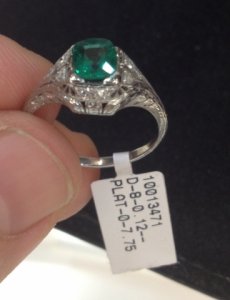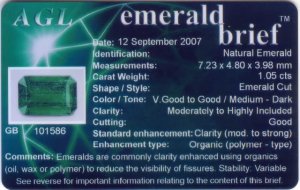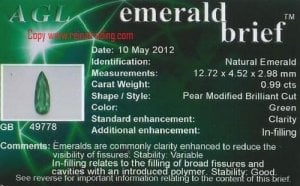Hi All,
I am new here and have a question about buying an emerald. I am thinking about buying a vintage art deco platinum setting that can hold a 5-5.5mm round or cushion cut stone (see below. the stone in the picture is a cushion cut). The store (a reputable, non-chain store, in Boston's downtown crossing area) also had some round and cushion cut emeralds. They seem to be good shape with great color, great saturation, jardin that not visible with the naked eye but were definitely there under the scope. The Jeweler said that it was a well cut stone with no window or extinction. I don't know anything about this, but I could not see anything negative about these stones.
The one that I liked the most was a .99carat 5.5mm round cut emerald graded very fine and the price he quoted was 2k. The question I have is this: when I asked if this stone is certified, the jeweler said that it was not and that it would cost $400 to certify it. This concerned me because once I got home and did some research, I found that AGL does a gem brief for $65. So was this a mis-communication? Did I mis-use the term certification when I really should have specified a gem brief?
He said that most of his diamonds have certification but that these emeralds did not and that its hard to find ones that already come withpaper. He said that he will look around for me to see if he can track one down for me.
Because I'm buying a vintage setting first and then buying an emerald that fits it, I have much less flexibility about the stone. I haven't been able to find a 5-5.5mm round cut emerald online. Should I be worried? Should I get the stone and then get a gem report on my own just so I know what kind of treatment was applied to it.
Thanks!

I am new here and have a question about buying an emerald. I am thinking about buying a vintage art deco platinum setting that can hold a 5-5.5mm round or cushion cut stone (see below. the stone in the picture is a cushion cut). The store (a reputable, non-chain store, in Boston's downtown crossing area) also had some round and cushion cut emeralds. They seem to be good shape with great color, great saturation, jardin that not visible with the naked eye but were definitely there under the scope. The Jeweler said that it was a well cut stone with no window or extinction. I don't know anything about this, but I could not see anything negative about these stones.
The one that I liked the most was a .99carat 5.5mm round cut emerald graded very fine and the price he quoted was 2k. The question I have is this: when I asked if this stone is certified, the jeweler said that it was not and that it would cost $400 to certify it. This concerned me because once I got home and did some research, I found that AGL does a gem brief for $65. So was this a mis-communication? Did I mis-use the term certification when I really should have specified a gem brief?
He said that most of his diamonds have certification but that these emeralds did not and that its hard to find ones that already come withpaper. He said that he will look around for me to see if he can track one down for me.
Because I'm buying a vintage setting first and then buying an emerald that fits it, I have much less flexibility about the stone. I haven't been able to find a 5-5.5mm round cut emerald online. Should I be worried? Should I get the stone and then get a gem report on my own just so I know what kind of treatment was applied to it.
Thanks!










300x240.png)